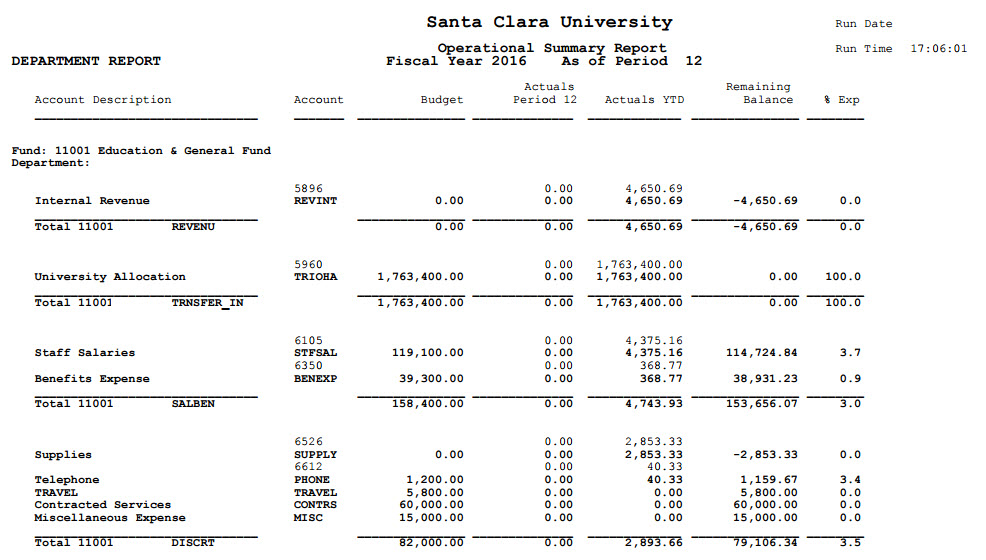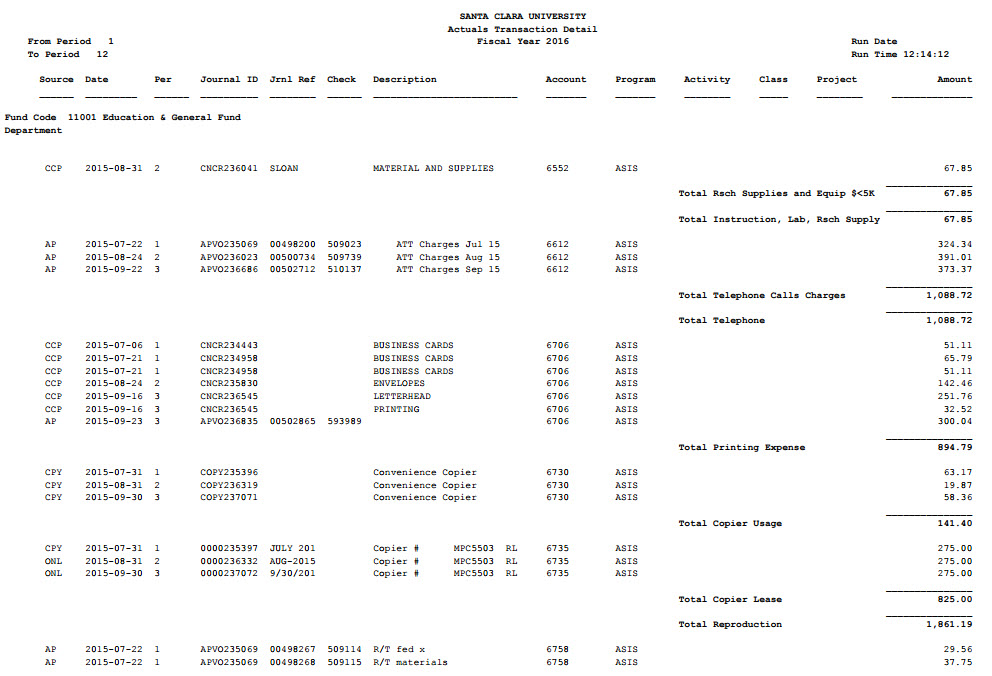Best Practices
The system of record for budget and actual transaction reporting is PeopleSoft Financials (https://financials.scu.edu). Expand the sections below for samples of 2 reports considered to be best practice budget to actual reporting at SCU.
In addition to the budget office recommendations, please also check with your budget manager to ensure any school/college/unit specific reporting and analysis needs are met as well.
The operational summary report is a standard report available on the Financials Management menu within PeopleSoft Financials. The below image shows a sample of the report output which summarizes budget and actual transactions for a particular fund and department combination as of the requested fiscal year and accounting period. Actual transactions are also broken down for the individually requested period as well as a year-to-date cumulative total by account code. This report can be run for an individual department and fund combination or it can be run for a treenode of departments. If run for a treenode, each department is still displayed individually the report just automatically includes a specific set of departments (ie. all of Arts & Sciences, or University Relations) in succession in the report.
How to Read the Operational Summary
The header information at the top tells you the financial accounting period (July = 1, June = 12), the fiscal year, the fund and the department.
Reading down the page, the main content of the report automatically groups accounts by type (Revenue, Salaries and Benefits, etc) and displays account details/names. To note, actual transactions are booked to financial accounts represented by numbers (5896, 5960, 6105, etc). Budget transactions are booked to budget accounts represented by alpha accounts (REVINT, TRIOHA, STFSAL, etc). Each grouping of accounts (Revenue, Salaries and Benefits, etc) includes both actual and budget transactions.
Reading from left to right, the first column includes text account descriptions for the account groupings and budget accounts. The descriptions for the financial accounts are not represented. To find more information on the descriptions for financial accounts, please visit Managing Financial Information for the accounting string codes/definitions. Next the respective account number (Alpha/Numeric) is also listed - budget and actual. The following column includes the summarized annual budget for the respective accounts. Followed by the actuals for the requested period. In the example below, the report was run for period 12 (June) and fiscal year 2016. As such, the Actuals Period 12 column provides a summary of any actual transactions which occurred during period 12. The column directly after that summarizes the actual transactions by account for the entire fiscal year to the end of the period requested. In the example below, the Actuals YTD column summarizes actual transactions from period 1 through period 12. If the same had been run for period 6 (December), then the Actuals YTD column would summaries transactions from period 1 through period 6. The final 2 columns on the report are created by applying basic math principles to the values pulled in on the first half of the report. Remaining Balance calculates the remaining budget from the Actuals YTD. And % Exp calculates the remaining budget as a percentage of the original planned budget.

The actual transactions details report is a standard report available on the Financials Management menu within PeopleSoft Financials. The below image shows a sample of the report output which summarizes actual transaction detail for a particular fund and department combination as of the requested fiscal year and accounting period. This is an excellent report to use to get further clarity on actual transaction history or to investigate actual totals from the Operational Summary that are not in line with expectations. The actual transactions details report can be generated for an individual department and fund combination and can be broken out into activity and class as desired. No budget information is included in this report.
How to Read the Actual Transactions Details
The header information at the top tells you the financial accounting period (July = 1, June = 12), the fiscal year, the fund and the department.
Reading down the page, the main content of the report automatically groups accounts by type (Supplies & Equipment, Telephone, Copier, etc.) and displays account number, journal ID, transaction date, transaction description and more. No budget data is included in the line items - the details are all related to the actual transaction booked within PeopleSoft Financials. All transactions - revenue & expense - are listed as positive numbers within this report. When a negative number is used, that represents a dollar value that has been backed out or decreased from the respective fund/account combination.
Reading from left to right:
- Source - indicates where the data came into PeopleSoft from. For example, "AP" stands for accounts payable.
- Date - represents the transaction date or the date the transaction was posted within PeopleSoft.
- Per - stands for Period or accounting period/month. July - 1, June = 12.
- Journal ID - PeopleSoft Financials Journal ID.
- Jrnl Ref - If specified in the journal entry, any journal reference text is included in this column.
- Check - If the entry is a result of a check, the check number is included in this column.
- Description - The short text description from the journal entry.
- Account - the financial account number
- Program - The program code specified as a part of the accounting string will appear in this column.
- Activity - If an activity was specified as a part of the accounting string then it will appear in this column. If the column is blank, no activity is associated with that transaction.
- Class - If an class was specified as a part of the accounting string then it will appear in this column. If the column is blank, no class is associated with that transaction.
- Project - If an project was specified as a part of the accounting string then it will appear in this column. If the column is blank, no project is associated with that transaction.
- Amount - The dollar value of the transaction.

The Actual Transactions Detail report described above is also available as a downloadable .CSV file. This file type is compatible with MS Excel and the list data available is easily pivoted once the file is opened in Excel.

Our newest feature added to the .CSV export is the budget account and budget account name. The report still only includes actual transactions. However, each transaction is classified by both a financial account and a budget account. Thus, when the data is pivoted you can view your actual transaction amounts summarized by budget account. This a great way to bridge to the operational summary account or review as a stand alone report and map back to your micro budget workbook.
The below picture shows an example of the .csv file data used in a pivot table by budget account. This is showing actual transactions summarized by budget account.
